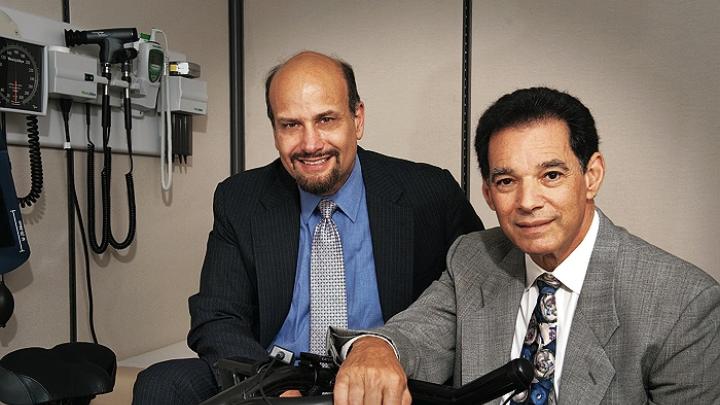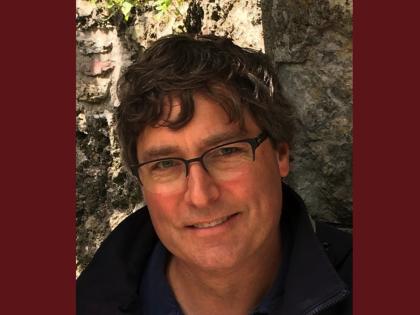In 2001, James Katz, M.P.H. ’83, received a startling finding from a physical exam: in the previous year, his stature had shrunk from six feet, two inches, to six-one. A medical workup showed a “lot of osteoporosis. I had the spine of a 70-year-old man, though I was only 51,” he says. “There was no back pain, but two vertebrae were compressed and all my disks flattened. This was a surprise. I was in good condition—I’d worn out two indoor bicycles—and ate a healthy diet.”
Tests revealed that Katz, a physician himself, was deficient in Vitamin D and testosterone. “They both help you make bone,” he says, so he began replacement therapy. He also started to explore integrative medicine. He took up weightlifting and began eating five small, low-carbohydrate meals per day. Within the next few years, Katz’s body size and composition changed, from 245 pounds and 30 percent body fat to 220 pounds and 18 percent body fat. Meanwhile, his blood pressure has dropped from 145/90 to 120/80—even though he is nearly a decade older.
Katz’s personal saga pointed him toward a new professional mission. Named “emergency physician of the year” in Massachusetts in 1996, he had switched from emergency-room work to occupational medicine in 2001. This year, with his medical partner, Bob Nadelberg, M.D. ’73, an anesthesiologist for 30 years, Katz launched Age Management Boston (www.agemanagementboston.com), an integrative medical practice that aims to keep its clients healthy and vital in the decades beyond 40. “There’ll be effects of aging, sure,” he says. “But do you want to be older and spending your time dealing with chronic disease—or be older and not spending your time dealing with chronic disease?”
The practice is affiliated with Cenegenics, a Las Vegas-based medical institute that has trained physicians in a “comprehensive, evidence-based” system of “age management” since the mid 1990s. So far, Cenegenics has evaluated 15,000 patients and trained 150 doctors who now practice in the United States. Though age management is not a board-certified medical specialty, it is an emerging field that is likely to grow as the baby-boomer population matures. Nadelberg and Katz don’t accept Medicare or health insurance (“Insurance companies don’t understand what we do,” Katz says), though clients can put aside pretax dollars to pay for their services. Costs range from $4,000 to $8,000 per year (above and beyond normal health insurance premiums), skewed toward the lower end of that range, they report. Their upscale clientele is 70 percent male; a few are under 40 or in their 80s, but the average new patient is a 50- to 55-year-old male.
With age, hormone levels fall. In women, there are the relatively discrete changes of menopause; “with men, it’s more subtle,” says Nadelberg. “A loss of energy, the need for afternoon naps, libido falls off, and cognitive processes get duller.” To address such symptoms, Katz and Nadelberg do things most doctors don’t, such as laboratory screenings of more than 100 tests, including insulin levels and hormone panels for estrogen and testosterone. They try to get clients off certain drugs, like antacids: “Without enough stomach acid, vitamin B-12 absorption goes way down,” Katz explains.
They also order DEXA scans (which use two x-ray beams with differing energy levels; they use a specially calibrated DEXA scan on a machine with different software and a longer bed) to measure density of bone, muscle, and fat. “Women have DEXA scans after menopause to monitor signs of osteoporosis,” says Nadelberg, “but men’s bone density falls off as well.” Standard guidelines recommend scanning men for osteoporosis beginning at age 70, but Katz says that “as soon as men get short of testosterone, they’ll start to get osteoporosis,” and he and Nadelberg order DEXA scans for nearly all their clients. (According to the National Institutes of Health, the radiation exposure of .001 rem or less from a DEXA scan is comparable to average exposure from natural background radiation sources.)
The doctors’ approach to Type 2 diabetes, which Nadelberg calls “a huge wave” approaching the healthcare system, is heterodox. High blood glucose levels flag diabetes, but “the first stop sugar makes in your body is in the muscles,” Katz explains. “Your bloodstream will contain about four grams of glucose, your liver 60 to 70 grams, and your muscles, 180 grams—or even more if you increase muscle tissue.” Consequently, the doctors’ counsel involves both weight management (a central element in all diabetes treatment) and weight lifting, or other exercises to build muscle.
But “most people over 50 can’t build muscle without the right hormone substrate,” says Nadelberg. “They’ll go to the gym and work out, but see no results.” The physicians may then prescribe testosterone replacement, because that hormone “is essential to building muscle,” Nadelberg explains. “Testosterone has gotten a bad rap. Bodybuilders and pro athletes have been using it without medical supervision and increasing their levels to way outside the healthy range. We do careful lab monitoring—we’re looking to balance and optimize hormone levels within normal ranges.” For Nadelberg and Katz, therefore, testosterone supplementation for Type 2 diabetics often makes sense. “Replacing testosterone to levels within the normal physiological range is reasonable and often helpful,” says associate clinical professor of surgery (urology) Abraham Morgentaler ’78, M.D. ’82, a noted researcher in this area and author of the book Testosterone for Life. Furthermore, Morgentaler notes that data suggest “no reason to be concerned that raising testosterone levels will increase the risk of prostate cancer.”
Even so, testosterone supplementation for Type 2 diabetics doesn’t fit standard medical practice. But Katz and Nadelberg don’t mind being mavericks. “Health-insurance goals are based on average outcomes,” says Katz, “and average outcomes aren’t fun”: he cites parameters from an American Geriatrics Council program based at Boston’s Beth Israel Deaconess Medical Center showing that, by age 75, people undergoing “normal aging” can expect to have three of these six conditions: frequent falling, urinary incontinence, confusion and memory loss, osteoporosis or arthritis, heart disease, and depression.
Katz and Nadelberg, instead, look to help clients like one busy executive who’d gained 20 pounds in the past five years while losing his energy, libido, and concentration. His previous doctor had told him, “You’re just getting older.” The key issue, though, is not the undeniable fact, but the how of aging. As Katz says, “If you don’t succeed in doing the things that are important to you in your life, then we aren’t succeeding as your doctors.”








